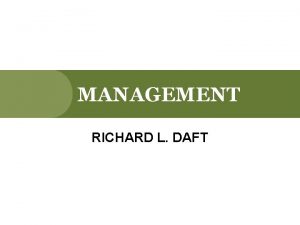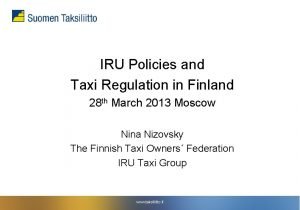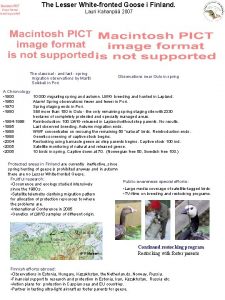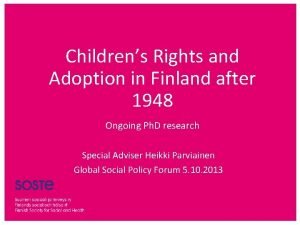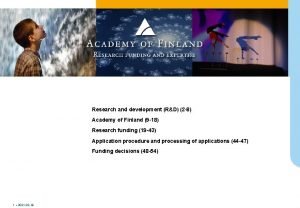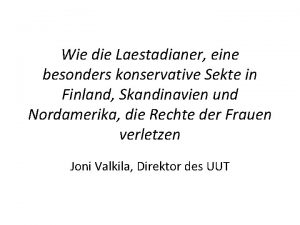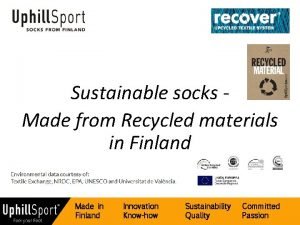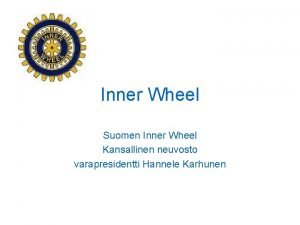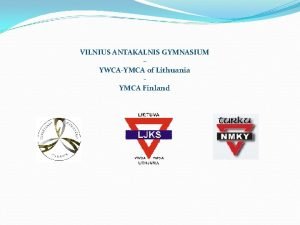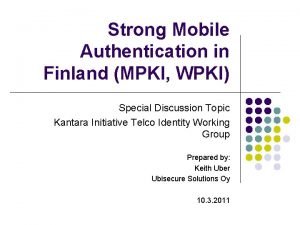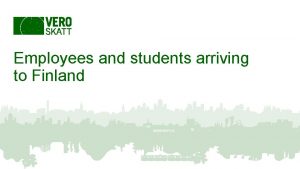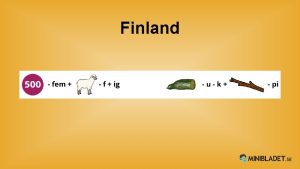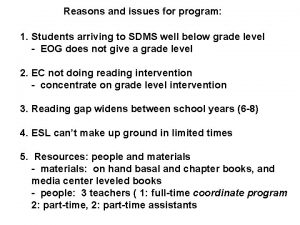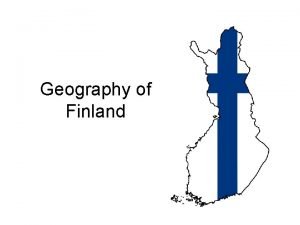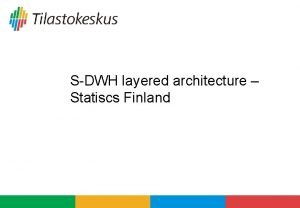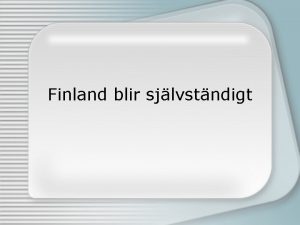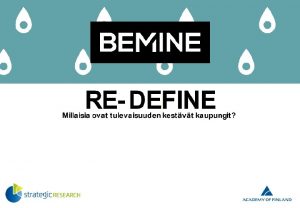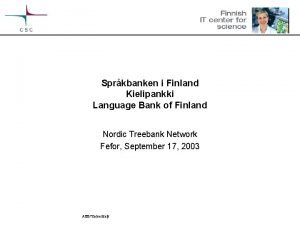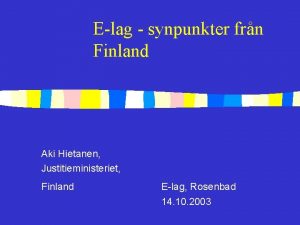Employees and students arriving to Finland This presentation




































- Slides: 36

Employees and students arriving to Finland

This presentation is… …about Finnish income tax, procedures of taxation and the tax obligations you should be aware of. – Taxpayer status • nonresident / resident • Being a tax resident of a country as it is agreed in Tax Treaty. – Rules that apply to a nonresident • Tax at source / Tax under the progressive scale / 75% rule • Tax-at-source card / Nonresident's card / Pre-paying income tax – Rules that apply to a resident • Tax cards and prepayments • Finnish personal identity code • Individual Tax Number – Impact of tax treaties on students – Mandatory insurance coverage 2 2. 10. 2020

Introduction Usually, anyone who works in Finland must pay Finnish income tax. Important factors affecting tax treatment: § How long you stay (your taxpayer status) § The country where your permanent home is located and where you have vital interests and personal ties (the country of tax residence under the Tax Treaty) § Limitations in Tax Treaties: – Employer's country of tax residence: Finnish or foreign? – Is your work an employee-leasing arrangement? – Does tax relief foreign students apply? § Which one of the countries gives you social security coverage? 3 2. 10. 2020

Decisions regarding taxpayer status § Finnish tax authorities first examine the newly arrived employee's/student's taxpayer status, applying the provisions of national Finnish law: – Nonresidents i. e. taxpayers with limited liability to pay tax are those who have not stayed in Finland during the tax year or have only stayed for a shorter period. – Residents, having unlimited tax liability, are people who live in Finland, and additionally, people who live in other countries but are staying in Finland longer than six months. § For more information on the concept of nonresidency, see 'General and limited liability to tax' / Yleinen ja rajoitettu verovelvollisuus. 4 2. 10. 2020

Tax treaties § Finland has negotiated tax treaties, also known as 'DTTs', 'double tax treaties' or 'conventions' with more than 70 countries of the world. § The purpose is to prevent double taxation. § The treaty Article on residency (known as the tie-breaker rule) affects your taxpayer status. The order of priority of the factors determining residency is the following : 1. Location of your permanent home. 2. Country where your personal and financial ties i. e. relationships are stronger (the centre of vital interests). 3. Country where you stay habitually. 4. Country where you are a citizen. 5 5. If you have citizenship of both (or neither) of the two countries, there must be a mutual agreement made between the competent authorities of these countries as to where your residency is 2. 10. 2020 deemed to be (this procedure is rare).

Tax treaties § If you are a resident of Finland, you must pay Finnish taxes on any income from foreign sources, too – The foreign-source income is normally also taxed in the country where it came from. § Finland eliminates the double tax either by credit or exemption method § Credit method means that foreign-source income is taxed in Finland, but the tax paid abroad is deducted i. e. credit is being granted for it, maximally to the amount of the Finnish tax. § Exemption method means that Finland treats the income as exempted from taxes but not exempted from your progression § No Finnish tax needs to be paid on foreign-source income. § However, it affects your tax percentage on Finnish-source income. § To have double taxation eliminated, you must ask for it. 6 2. 10. 2020

Tax assessment of nonresidents § Nonresidents pay Finnish tax on their Finnish-source income only. Examples: – Wages, pensions paid by a public organization in Finland – Wages, pensions paid by a private-sector employer in Finland if more than half of the work is done in Finland – Wages paid to a leased worker (employee leasing) – Income from business profits and professional activity – Income from agriculture and forestry – Fees received by a member of a Board of Directors – Dividends and interest – Royalties – Income deriving from a unit of real estate or from an apartment or flat. 7 2. 10. 2020

Tax assessment of nonresidents § Tax treaties may pose limitations of Finland's taxing rights with respect to wage income if the employer is foreign and has no permanent establishment in Finland the worker does not stay longer than: – 183 days per calendar year or – 183 days out of a 12 -month period or – 183 days out of a tax year: § 8 2. 10. 2020 for example, the tax year of New Zealand begins April 1 and ends March 31.

Tax assessment of nonresidents § Finnish tax on leased employees' earnings must be paid although no permanent establishment exists if the leased employee has arrived from: – Since 2007: Estonia, Latvia, Lithuania, Denmark, Iceland, Norway, Sweden; – Since 2009: Moldova, Georgia, Belarus, Isle of Man; – Since 2010: Jersey, Guernsey, Bermuda – Since 2011: Poland, Kazakhstan, Cayman Islands – Since 2013: Turkey; – Since 2014: Cyprus and Tajikistan. § In addition, Finnish tax on leased employees' earnings must be paid if they come from non-tax-treaty countries. § Read more: Leased employees – taxation in Finland 9 2. 10. 2020

Tax assessment of nonresidents The following procedures are possible: 1) Your wages are subject to tax at source, where the tax rate does not change as you earn more 2) Your wages are subject to progressive income-tax schedule, with foreignearned and Finnish-earned earnings having impact on your tax rate 3) Your wages are subject to progressive income-tax schedule without worldwide income (the 75% rule) Read more: Taxation of the earned income of nonresident individuals: Tax at source or Progressive tax. 10 2. 10. 2020

Taxation at source § Tax is withheld at the flat 35% rate on wages + fringe benefits. – Before withholding the tax the payor makes a special deduction called 'source tax deduction' (lähdeverovähennys; källskatteavdrag) on the condition that your tax card has instructions to that effect. § The deduction is € 510 per month or € 17 per day for pay periods shorter than one month. – However, the deduction cannot be higher than the amount of income. § Pay received by an artiste, athlete or sportsman: 15% rate. § Computation of the premiums to be paid for healthcare insurance, pension insurance and unemployment insurance is based on the gross income prior to the deduction; see following slide. – People arriving from other countries may normally get coverage by the Finnish social security system if they work for at least 4 months. 11 2. 10. 2020

Taxation at source § Illustration: – On 1 May, Stefanie starts working for a Finnish employer in Finland, contract end date being 9 September. She has obtained a card for tax at source at the tax office. She hands it over to her employer. – The withholding is 35% but the card has the instruction to deduct € 510 or € 17 first. It also is printed on the card that the health insurance premiums are based on the total wages subject to tax at source. – Stefanie earns € 7, 000 gross for her entire contract and the deduction adds up to € 2, 193 (4 months × € 510 + 9 days × € 17 = € 2, 193), so her employer withholds the source tax on € 4, 807. This is the base for her tax at source. – However, the base for healthcare, pension, unemployment insurance cost is € 7, 000. 12 2. 10. 2020

Taxation at source § Ask the tax office to give you a tax-at-source card when your wages are taxable in Finland you are working for: – a Finnish business – a foreign business treated as having a permanent establishment in Finland – a foreign business registered as an employer in Finland. § Ask for the card if you are not sure whether you are going to stay longer than 6 months. – If it turns out you are staying longer, ask for a resident's tax card. § All the money you've been paid so far ‒ and withheld so far ‒ is taken into account when the tax office works out your new withholding rate. § Hand the card over to your employer. – If you fail to give them a tax-at-source card, your pay is taxed as 13 § being paid to a beneficiary with unknown status: 60% is withheld. § When your employer is aware that you are a nonresident, only 35%. 2. 10. 2020

Taxation at source § If you are a leased employee and your employer is a foreign leasing agent: Ask the tax office to give you a prepayment decision when your wages are taxable in Finland and: – your employer has no permanent establishment, – your employer is not on Register of Employers. § Pay the prepayments yourself. § For a tax-at-source card or for the prepayments, complete Form 5057 e (Application for a nonresident taxpayer's tax-at-source card, prepayment calculation, tax card). 14 2. 10. 2020

Taxation at source § The tax office can prepare the card even if you don't have a Finnish personal ID code unless you are a construction worker. – However, the Tax Administration recommends that you get the ID code anyway. § When you are taxed under this scheme, the tax withheld at source is your final tax, and you do not have to file a tax return in Finland. § You must file a tax return in your country of residence and include details on your Finnish-source income. § Any double taxation is eliminated by the authorities of your country. 15 2. 10. 2020

Progressive taxation § Nonresident individuals can ask for tax treatment under the progressive scheme instead of source taxation if: – the individual's country of residence is in the EEA; or – in a country that has signed a tax treaty with Finland; or – the individual is a reasearcher and has a residence permit covered by the EU Directive on Scientific Research. § Finnish tax imposed on Finnish-source income only. – However, when the progressive scale determines the tax rate to be applied on your earnings, any foreign-sourced wages, pension, and social benefits are included in the computation if these would be taxed as earned income if they were from a Finnish source, and if their sources are: § outside Finland, and your country of residence treats the income as taxable § in Finland, and the applicable tax treaty prevents Finnish taxation on it. § Allowed expense deduction foreign-source income: expenses for the production and maintenance of income. 16 2. 10. 2020

Progressive taxation If you are a citizen of an EU/ETA member state: § To ask for tax treatment under the progressive scheme you need a Finnish personal ID code. – Complete Form 6150 e to ask for the ID code: Registration information on a foreigner staying in Finland temporarily. – When visiting the tax office to file the form, present the following documents: § A valid passport/identity card of the Schengen zone. § If more than 3 months have elapsed after your arrival in Finland, an immigration service issued certificate proving that your residence has been registered. § Your employment contract or other documentation on your terms/conditions of employment in Finland. 17 2. 10. 2020

Progressive taxation If you are NOT a citizen of an EU/EEA country: § To ask for tax treatment under the progressive scheme you need a Finnish personal ID code. – Complete Form 6150 e to ask for the ID code: Registration information on a foreigner staying in Finland temporarily. – When visiting the tax office to file the form, present the following documents: § A valid passport § Residence permit issued for an employee (if you work… 18 2. 10. 2020

Progressive taxation …in Finland in a job not listed in Aliens' Act). § An exception from the above rule are construction workers, permanently employed by a company resident in the EU or the EEA, who arrive to Finland for short periods in order to complete temporary subcontracts, and their residence permits and work permits are valid in the country of domicile of the company they work for. § Your employment contract or other documentation on your terms/conditions of employment in Finland. 19 2. 10. 2020

Progressive taxation § Ask the tax office for a nonresident's tax card. Then hand the card over to your employer. – Complete Form 5057 e: Application for a nonresident taxpayer's tax-at-source card, prepayment calculation, tax card. § Complete the following form to enclose with it: – Application for progressive income taxation (Form 6148 e). § Forms are available for downloading on – tax. fi/forms 20 2. 10. 2020

Progressive taxation § Your request can only concern one year at a time. § Give details on the following when filing your request: – all Finnish-source income, all income taxable in your country – the deductions that support all that income. § Once the progressive treatment has been agreed, you cannot ask for taxation at source for that year anymore. § Tax office will send you the Pre-Completed Tax Return. – = a specification of your income, deductions and the result of your taxation (whether you must pay more/whether you get a refund). – Go over the pre-filled amounts; if you notice errors/omissions, make corrections and send the form back. § Request for progressive treatment is also accepted after the tax year. – Either send the form back or lodge a Claim for Adjustment. 21 2. 10. 2020 – Enclose: Application for the progressive scheme (Form 6148 e).

Progressive taxation – the 75% rule § Foreign-source income is not included in the progression if the taxpayer's net taxable income from Finland is at least 75% of the total of their net taxable income, received from Finland other countries. – This rule only applies to EEA residents and holders of residence permits covered by the Directive on Scientific Researchers. – Net taxable income = income subject to tax – natural deductions (expenses for the production of income, commuting, membership fees of trade unions. ) § Show documentation from country of residence to prove the amounts of your foreign-sourced income. • This rule cannot be applied until final assessment. 22 2. 10. 2020

Tax assessment of residents § Residents pay Finnish taxes on their income whether sourced in Finland or foreign countries. § The treatment of a resident wage earner who arrives from a foreign country is similar to that of people who live in Finland on a permanent basis. – Earned income is taxed under the progressive scale. – Capital income is taxed at 30%, but if the base is above € 30, 000 the rate is 34% on the exceeding part. – Residents living in Finland are entitled to the same expense deductions regardless of whether they are Finnish or foreign citizens. 23 2. 10. 2020

Tax assessment of residents § Ask for a tax card if you work for: – a Finnish business – a foreign business treated as having a permanent establishment in Finland or entered in the Finnish register of employers. § Ask for a prepayment calculation/decision if your circumstances are: – you work for an employer who is not treated as having a permanent establishment in Finland; and – the employer is not registered as an employer in Finland. § You must have a Finnish personal ID code both for getting the card and for getting the prepayment decision. 24 2. 10. 2020

Tax assessment of residents § Ask the tax office to either give you a tax cardor to give you a prepayment calculation. – Application for Tax Card/Prepayment Calculation – Current or previous foreign residents, arriving to Finland for longer than 6 months (Form 5042 e). – If you are going to work on a construction site, complete Form 5042 e also for getting a Tax Number. § Either hand the card over to your employer or pay the prepayments by their due dates. § Tax office will send you the Pre-Completed Tax Return. – = a specification of your income, deductions and the result of your taxation (whether you must pay more/whether you get a refund). – Go over the pre-filled amounts; if you notice errors and omissions, make corrections and send the form back. 25 2. 10. 2020

Finnish personal identity code § The requirement to have the ID code is in force if you start work in Finland need: – a nonresident's tax card / prepayment calculation – an individual Tax Number. § To get your ID, visit a tax office/Local Registration Office in person. § Fill out Form 6150 e: – Registration information on a foreigner staying in Finland temporarily § The ID is free-of-charge. § Documentation you must have: see slides 17 and 18. § Read more – Finnish personal identity codes for workers. 26 2. 10. 2020

Individual Tax Numbers § Tax Numbers are necessary for construction workers. § To get the number you must first have a personal ID code. – You also have to show your employment contract or other documentation explaining the terms/conditions of your work in Finland. § If you are a nonresident, complete Form 5057 e – Application for a nonresident taxpayer's tax-at-source card, prepayment calculation, tax card (5057 e) § If you are a Finnish resident, complete Form 5042 a – Application for a tax card / prepayment calculation – Current or previous foreign residents, arriving to Finland for longer than 6 months (5042 e) – Read more: tax. fi/taxnumber 27 2. 10. 2020

Tax treaties with relief clauses for students § If you arrive in Finland as a foreign student, your status and country of tax residence are determined in the same way as for employees who arrive. § However, being a student, you may enjoy treaty-based relief from Finnish tax. – Relief can apply to residents and nonresidents alike. § Finnish tax is normally not collected on the income of a student or trainee arriving from other countries. Examples of such income include academic grants and EU-paid student's allowance. § Read more: Academic studies in Finland 28 2. 10. 2020

Examples of relief clauses in Tax Treaties § If you are a student and you work for a Finnish employer, your pay is taxable, and most treaties do not restrict Finnish taxation. § Exception to this rule: your work in Finland is connected with your studies in your country. – In these circumstances, a treaty-based deduction can be made on the condition that your tax card/tax-at-source card contains instructions to that effect. – Please contact the tax office to ask for a card. – Bring along your Student's ID card or documentation proving you are a student. – When you have the card, hand it over to your employer. 29 2. 10. 2020

Examples of relief clauses in Tax Treaties § To be eligible for relief for students, you must be treated as a resident of the other Contracting State within the meaning of the relevant tax treaty. Your status must be this just before you arrive. § Illustration: Céline from France pursued academic studies in London for three years just before she arrives in Finland – Treaty between France and Finland is not applicable to Céline if she does not present documentation proving that she continued to be a tax resident of France within the meaning of the France-Finland Treaty. – If necessary, Céline must show a certificate of fiscal residency from her country. This ascertains that the Finnish authorities apply the right treaty when assessing her taxes. 30 2. 10. 2020

Mandatory insurance coverages § Duration of your work is less than 4 months – No healthcare insurance is collected from you. § Duration is at least 4 months – You must pay healthcare insurance. – However, if you are a holder of an A 1 Certificate and come from EU/EEA/Switzerland, no healthcare insurance is collected. Similarly, if you come from a country with a Social Security Treaty with Finland have documentation proving you are a "posted employee". § Healthcare insurance premiums – If you are a resident, this is included in your withholding. – If you are a nonresident, you must pay the premiums in addition to paying your tax at source. § Pension and unemployment insurance contributions – If you have no A 1 Certificate - you must make the contributions, withheld on your pay. 31 2. 10. 2020

Mandatory insurance coverages § Payments required of 'au pairs' and trainees – If your earnings for work stay below € 1, 173 per month (in 2016) or if you work less than 18 hours a week, you are not covered by Finland pay no contributions. – If you arrive for longer than 2 years, you pay the contributions unless you hold a certificate from the Finnish Social Insurance Institution proving that you don't have Finnish coverage. § "Posted employees" from countries with soc. sec. treaty – from USA, Quebec and Israel § No healthcare is collected for the time when documentation proving your "posted employee" status is in force. – from Australia, Canada, India and Chile § No healthcare is collected if you have obtained a certificate from the Social Insurance Institution (KELA) proving you are not covered by Finnish sickness insurance or by the Finnish residence-based social security scheme. 32 2. 10. 2020 – soc. sec. treaties with these countries do not apply to sickness insurance

Mandatory insurance coverages § You must pay healthcare premiums in the following circumstances even if you don't arrive to Finland have no A 1 Certificate. – If you come from other countries than EU/EAA/Switzerland you work on board a Finnish ship for at least 4 months. § Pay the premiums regardless of the time limit if your employment is covered by the Seafarers’ Employment Contracts Act. – If your work involves stays in two or more states (e. g. you are a driver of heavy transport) you normally have coverage in the country of residence of your employer. § However, if you work in your own country of residence to a significant extent (at least to 25%), you have coverage in your country. 33 2. 10. 2020

Mandatory insurance coverages § Illustration: – Erik arrives in Finland to work 3 months; his pay is € 1, 400 per month. – He is treated as being a nonresident, so he needs a tax-at-source card. He does not ask for treatment under the progressive scheme when he files the papers. – The tax office issues Erik a tax-at-source card (lähdeverokortti; källskattekort) instructing the employer to withhold 35%. An entry on the card says € 510 per month or € 17 per day is deducted upfront. – Erik is not required to pay healthcare insurance because the duration is shorter than 4 months. 34 – However, he must pay pension and unemployment insurance unless he has an A 1/E 101 Certificate. 2. 10. 2020

Read more on Tax. fi § Taxation of employees from other countries § Leased employees - taxation in Finland § Arriving in Finland to work for a Finnish employer § Employees arriving in Finland/bulletin foreign taxpayers § Finnish personal identity codes for workers arriving in Finland § Taxation of the earned income of nonresident individuals: Tax at source or Progressive tax § Individual Tax Numbers — instructions for use 35 2. 10. 2020

36 2. 10. 2020
 Departure procedure in hotel
Departure procedure in hotel Induction presentation for new employees ppt
Induction presentation for new employees ppt Champion of filipino students
Champion of filipino students Finland facts and information
Finland facts and information Presentation in hindi topic
Presentation in hindi topic Fetal lie
Fetal lie Vertex presentation and cephalic presentation
Vertex presentation and cephalic presentation Motivating and satisfying employees and teams
Motivating and satisfying employees and teams Motivating and satisfying employees and teams
Motivating and satisfying employees and teams Is the individual internal process that energizes directs
Is the individual internal process that energizes directs Motivating and satisfying employees and teams
Motivating and satisfying employees and teams Motivating and satisfying employees and teams
Motivating and satisfying employees and teams Easter origin
Easter origin Finland exams
Finland exams Taxi license finland
Taxi license finland Finland homelessness solution
Finland homelessness solution Oat export finland
Oat export finland Brittney jones starbucks
Brittney jones starbucks Aki parviainen business finland
Aki parviainen business finland Ytv2012
Ytv2012 Finland goose
Finland goose Ti finland
Ti finland Fiskars fashion
Fiskars fashion Music festivals finland
Music festivals finland Adoption in finland
Adoption in finland Finland education budget 2021
Finland education budget 2021 Lestarianer
Lestarianer Technical
Technical Socks from recycled materials
Socks from recycled materials Finland capital map
Finland capital map Technology industries of finland
Technology industries of finland Inner wheel finland
Inner wheel finland Finland fields
Finland fields Special education in finland
Special education in finland Y. m. c. a.
Y. m. c. a. Regional state administrative agency for southern finland
Regional state administrative agency for southern finland Tupas finland
Tupas finland








